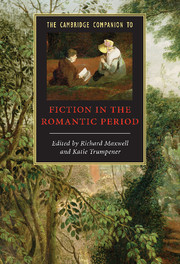This Companion offers an introduction to British fiction written between roughly the mid-1760s and the early 1830s. Across Europe, these seventy years encompass a large number of artistic works conceived in Romantic styles: symphonies by Ludwig van Beethoven, picturesque landscape gardens, paintings by Eugène Delacroix, the visionary domestic architecture of Sir John Soane, and the Gothic novel. Yet many novels and tales of these decades are not identifiably Romantic in style or sensibility. On the whole, the era may be characterized less by a unifying artistic sensibility than it is by a spirit of experimentation, and an overall political situation, a civic unrest traceable throughout Europe and North America.
The period was turbulent. The Russians, under Catherine the Great, fought the Ottoman empire (1768-74), while waging a less direct battle against their allies, the Bourbons of France, and fomenting political unrest on a European scale. One country affected was Greece, where Catherine's agents helped start a revolution against Turkish rule; the conflict lasted decades, becoming celebrated for its horrors and heroism. Catherine's domestic troubles included the peasants' revolt led by Pugachev (a Cossack soldier and pretender to the Russian throne, executed in 1775). Meanwhile, as historian Franco Venturi observes, rebellions and insurrections of many different kinds broke out all over Europe, especially “in unexpected and peripheral places.“ Among the countries affected were Corsica, Montenegro, Bohemia, Geneva, Denmark, and Sweden, each in turn seeming to provide another view of a confusing new world in revolt against old forms of social order. The culminating event of these decades of crisis was, of course, the French Revolution (beginning in 1789), with the long, bloody aftermath of the Napoleonic Wars, but the French upheaval was not an isolated event; almost everywhere in Europe, from the mid-eighteenth century onwards, a major realignment seemed to be under way.
